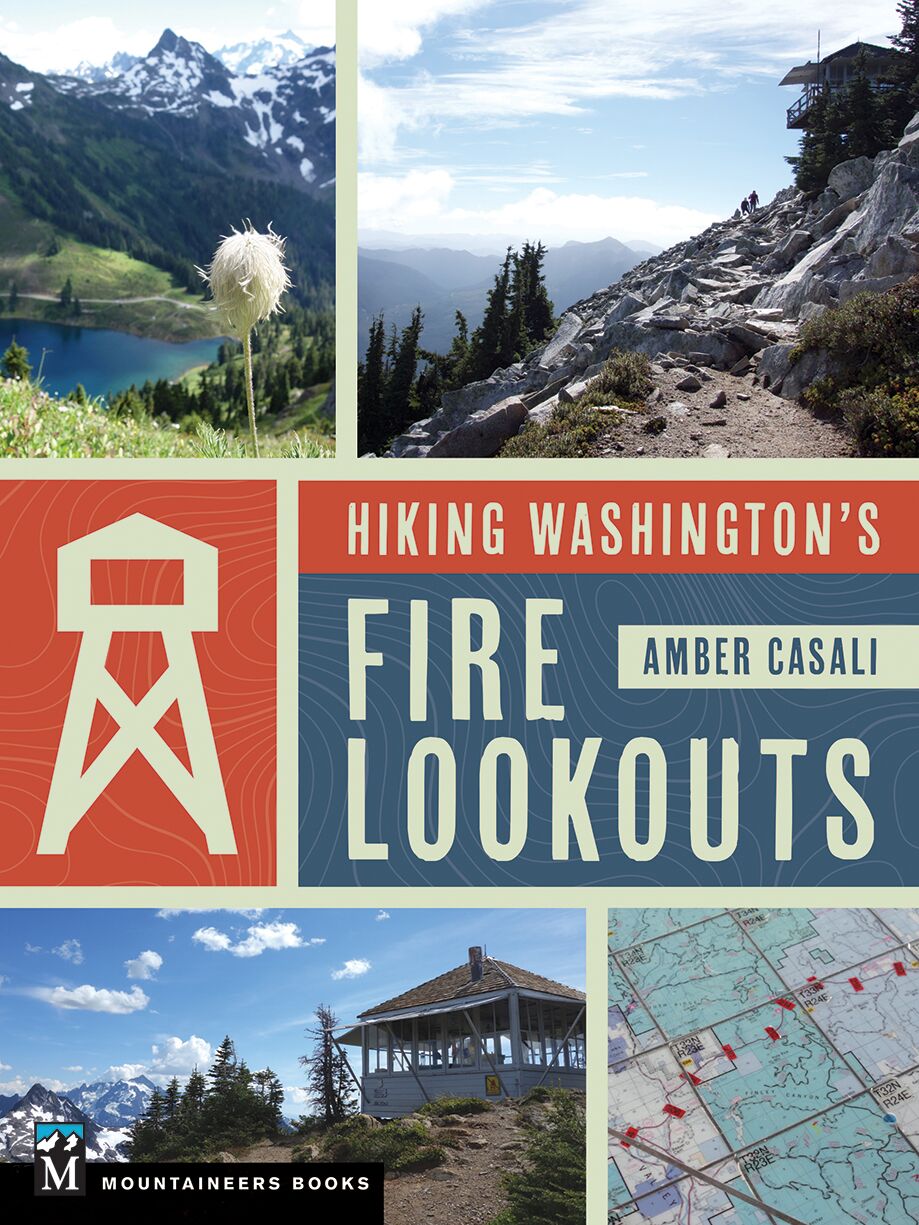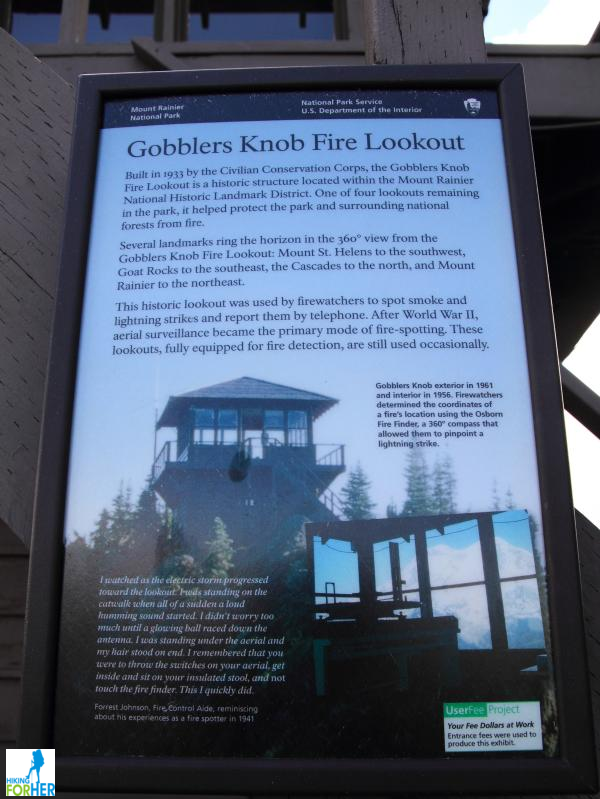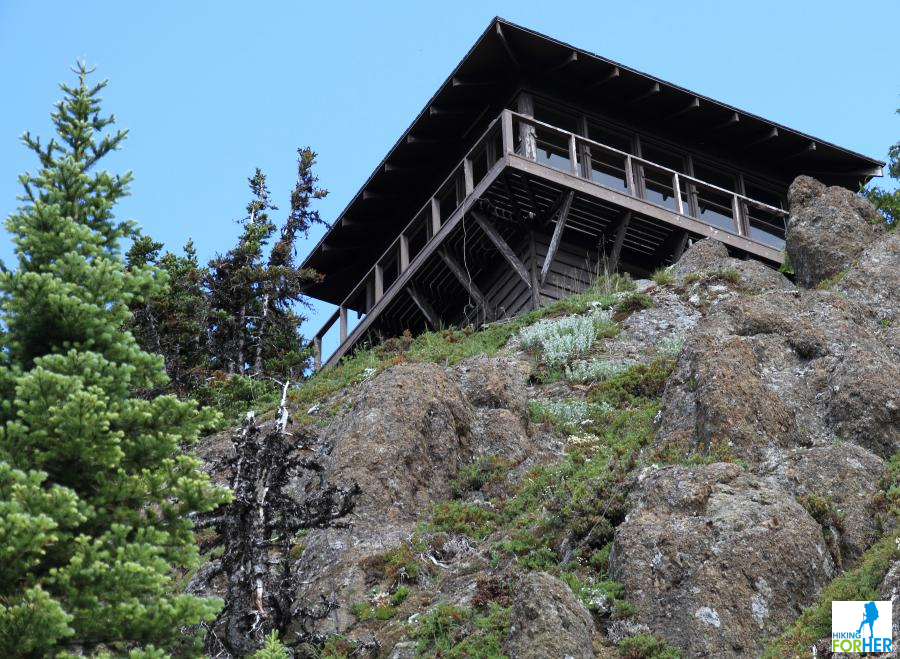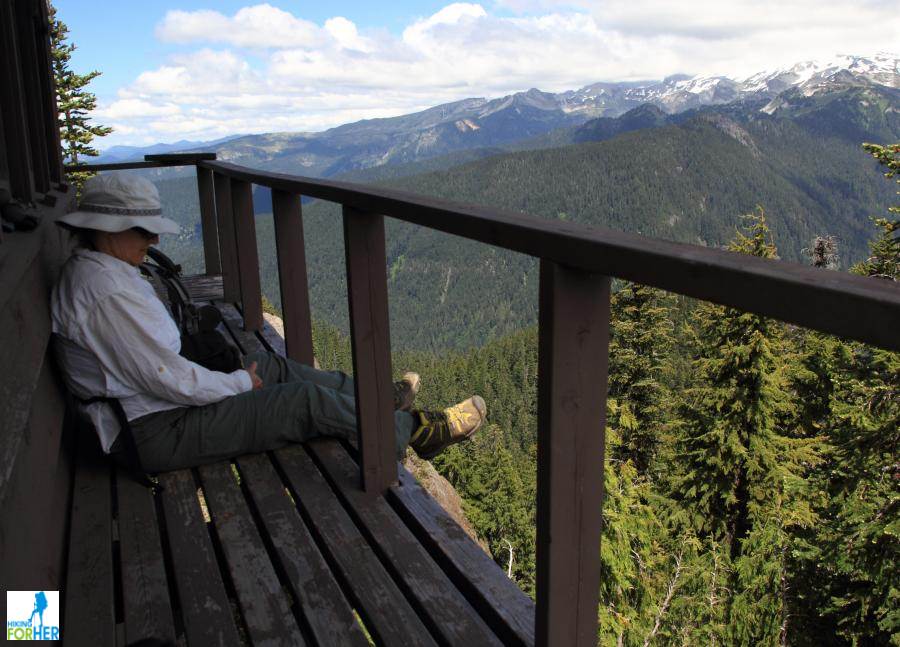Hiking For Her
Book Review
By Diane Spicer
Hiking Washington's
Fire Lookouts
by Amber Casali

This Hiking Washington's Fire Lookouts book review presents a novel approach for hikers of any age and ability level.
- Perfect for shaking up a stale hiking list
- Useful if you're headed to Washington State and need some reliable trail suggestions
Let's get one potential point of confusion cleared up right away:
- a fire lookout tower (physical structure) is where the fire lookout (job description) lives for the summer.
Keep reading to pick up some fresh ideas for Washington hiking destinations which combine state history and amazing panoramic views.
A few disclosures in this
Hiking Washington's Fire Lookouts
book review
Hiking For Her offered to write this book review.
Why?
- Because fire lookouts are an amazing hiking destination, and this book tells you exactly how to find them.
A copy of Hiking Washington's Fire Lookouts by Amber Casali was provided, free of charge, by Mountaineers Books.
- There is no affiliate or promotional relationship between us.
- All of the comments, photos and opinions belong to Hiking For Her.
For your personal copy, visit Mountaineers Books here.
- Note the 20% discount for Mountaineers members.
Hiking Washington's
Fire Lookouts:
how to choose
panoramic vistas
When people ask why I choose to live and hike in the Pacific NW, this is the answer I give them:
- Because I can reach plenty of panoramic vistas on a mere day hike, and many of them include an added bonus: historic fire lookout towers.
The photos in this book are going to tantalize you with some of these stunning vistas and viewpoints.
Of course, there are varying degrees of sweat and muscle power involved in earning the reward of a sweeping view from atop a lookout.
But you'll know ahead of time just how many energy bars to pack, because the author of Hiking Washington's Fire Lookouts is very clear about the round trip distance and elevation gain to reach each lookout tower.
She highlights this important information at the beginning of the book, in a chart entitled "Lookouts At A Glance".
- Use this information to tailor your hike to your preferred exertion level, or to reach a compromise with the abilities of all hikers in your group.
Hiking Washington's
Fire Lookouts:
perfect hiking for history buffs
The best way to scratch a combined history and hiking itch?
Use this book as a guide to plot your summer hiking adventures with an eye toward Washington history:
- The book briefly covers the construction timeline of these important structures.
- The author succinctly details the changes in communication and technology which led to their (astonishingly fast) demise.
You'll also find out which of a handful of towers are still being used today.
 Don't worry if you didn't read your history ahead of time! Some lookouts will give you the highlights as your reward for reaching them.
Don't worry if you didn't read your history ahead of time! Some lookouts will give you the highlights as your reward for reaching them.
Throw in a bit of poetic history
Another way to multi-task?
Work as a fire lookout by day (see the long list of weekly chores detailed in the book).
Write poetry and novels during the hours of darkness.
These names might ring a bell as folks who did exactly that:
- Jack Kerouac
- Gary Snyder
- Philip Whalen
I can hear you thinking:
"How can I stay overnight in a lookout?"
This book has the answer!
Hiking Washington's
Fire Lookouts:
customized hikes
The author splits the fire lookout hikes into 4 big state regions, and provides a large map to help you differentiate the boundaries:
- North
- Central
- South
- Olympic Peninsula
Use the map to set up your hiking destinations.
Spend the summer and early fall chipping away at the list, when low (or absent) snow levels allow you to access each lofty lookout.
It might also be fun to choose an area you don't normally explore within Washington State.
- Find a campground as base camp.
- Devote several days to visiting regional lookouts, especially when you have a clear weather window.
The easy to use map will help you set up a hiking itinerary, and revise it on the fly to accommodate weather conditions.
A timely book
It seems quaint today to think about this job description:
Wanted:
one human being*
unafraid of lightning or heights
to carry supplies & food
up to a craggy vantage point
and spend the weeks of high summer
watching for smoke on the horizon.
*usually male, with exceptions such as Hallie M. Daggett
Not so quaint in light of the recent devastating fire seasons in Western states!
Fire lookouts are once again an important tool in the human endeavor to fight forest fires.
Washington State once had nearly 600 lookouts; this book shares 44 of the 89 that remain standing in 2018.
Only a few are staffed during the fire season.
- Without sustained maintenance and care, these lookouts will be gone one day.
- Visit them soon, with the help of this book.
Best features
of the book
Amber Casali's words and photos offer you an accurate representation of a typical Washington lookout hiking trail.
It goes something like this:
start at low elevation:
- legs feel great, still fueled up from the breakfast pancakes...
hike through dense forested terrain, sometimes for miles, gaining elevation slowly but surely:
- legs are starting to feel it, breath is coming a bit harder, looking forward to stopping soon...
and finally break out into rocky high alpine terrain.
- Hurrah! Look at that view!!
Alternate but realistic Pacific NW ending:
- Bummer, too foggy to even see the tower.
Careful research
Over two hiking seasons, the author visited every lookout in this book.
She kept detailed notes, and whenever possible she talked with working fire lookouts and repair crews.
She spent the winter months digging into historical documents and reading books about fire lookouts.
All of this diligence produced a book you can rely upon for good trail descriptions, fascinating background information, and armchair hiking destinations (also called the hiking off season).
A fun way
to use the photos
Her photos of lookout towers make it easy for you to put them into the 3 basic design categories.
I won't spoil the fun, but here's a preview:
this is the underbelly of the Gobbler's Knob fire lookout, demonstrating just one construction approach to providing shelter and an unobstructed vantage point for a fire lookout.
 Gobbler's Knob fire lookout tower is perched atop a rocky outcrop. It provides stupendous views of Mount Rainier.
Gobbler's Knob fire lookout tower is perched atop a rocky outcrop. It provides stupendous views of Mount Rainier.
Heads up
About 50% of the lookouts listed in the North and Central regions of Washington State have been visited by me over a span of two decades.
This provided some basic fact checking, and the ability to agree or disagree with the author's impressions.
- I am happy to report that accuracy and attention to detail prevails throughout the hike descriptions.
Just one caution:
Every hike in the book has an associated map to show you the general area you'll be hiking through.
However, it is not (and probably was not intended to be) a detailed topographic map, so don't use it as a navigational aid.
Instead, use it as a general overview before you start your hike:
- the number and length of switchbacks you will encounter;
- the direction you will be hiking in;
- any surface water you will encounter.
Customize your hikes
Be sure to use the complete hike description to your advantage as you plan a hike:
- roundtrip distance
- elevation gain, in feet
- lookout elevation, in feet
- map suggestions from USGS, Washington State, and elsewhere to augment the book's maps
- GPS coordinates (because not all of your hikes will be on clear, sunny days)
- permits and fees required at trail head
All of this information allows you to plan the amount of water and food you need to carry.
Trail tip:
Take care to translate the hiking mileage and elevation gain (and subsequent loss) into your personal hiking pace.
Examples:
- What is deemed "short and easy" for one hiker might be an epic struggle for someone with recent knee surgery (downhill may be harder than uphill).
- Your hiking partner's tireless long legs can eat up the trail miles, but you might need several refueling stops along the way. This affects your turn around time.
Grab a copy
and lookout!
 Sitting in the shade on a fire lookout tower and admiring the view. Or napping after the strenuous hike up. You decide!
Sitting in the shade on a fire lookout tower and admiring the view. Or napping after the strenuous hike up. You decide!After writing this Hiking Washington's Fire Lookouts review, I have no hesitation in urging you to grab a copy.
- Just be prepared for the airy feeling of a few boards beneath your feet as you feast your eyes on the 360 views!
Home page > Hiking Resources >
Hiking Washington's Fire Lookouts
Book Review
|
I get emails all the time about what I wear, eat, carry and love to use on the trail. That's
why I provide affiliate links to you: the best gear that I use myself and have seen used by other hikers is instantly
available for your consideration, and the gear company sends a few
pennies per dollar to this reader-supported hiking website. There is no added cost to you! Everyone ends up a winner: Great gear for you, strong gear companies, and more free hiking tips for everyone. Thanks very much for your support. It's warmly and sincerely appreciated. It also helps send these hiking tips to all your virtual trail buddies around the globe. |
 |


